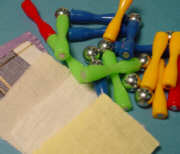BACKGROUND:
Introduce this lab by
telling students that all their clothing is made of fibers which are thin,
thread-like pieces of plant, animal or man-made (synthetic). However,
most fibers are polymers as discussed in the Pre Lab. The
principle use of fibers is in the manufacture of textiles, stuffing for
mattresses or upholstery, brushes, and paper. Fibers can be broadly
classified as coming from plant, animals or manufactured by humans.
Draw the following chart on
the board to illustrate some fiber or fabric types and where they come
from.
|
TYPE
|
PLANT
|
ANIMAL
|
SYNTHETIC
|
|
cotton
|
X
|
|
|
|
wool
|
|
X
|
|
|
polyester
|
|
|
X
|
|
nylon
|
|
|
X
|
|
jute
|
X
|
|
|
|
angora
|
|
X
|
|
Fabrics are made by interconnecting
or joining of fibers by the process of weaving, knitting, or felting (like
paper). Fibers are sometimes combined or mixed to make varieties
of fabric. For example, a shirt label that reads "75% cotton, 25%
wool" means that each strand of thread or yard of fabric there is
3/4 cotton fiber blended with 1/4 wool fiber.
In Forensic Science the study
of fibers helps to locate who may have been at a crime scene. Detectives
may find hair fibers from humans and analyze it for DNA or other properties
that can help find a suspect. Minute fibers from a rug can be found
on people's clothing, which can be traced to a carpet in a house or car.

Don't confuse fibers with the overall weave of cloth. That is
another kind of pattern.
PROCEDURE:
- Reinforce that most fibers are polymers. The
first exercise has the students use the magnetic ball and rods to make a
repeating chain of one or two patterns. This would be a polymer,
which repeats the original "mer". The molecule is
chemically not the same as a chain of the same molecule. They should come
up with a similar design as below.
- Students should
look at several samples of different fabric and see how the fibers are
woven together. Students should observe the fabric and record what
they see under the microscope. Make sure they do not confuse the
weave of the fibers with the actually fibers. To view the fiber,
direct students to the fringes of the piece of cloth.
- This exercise is not
only an introduction to investigating science, but also for students to
learn about different fibers. Emphasize with students that scientists
have to learn about different subjects by observing and recording information
before they can actually formulate a question about that subject.
Refer students to the "Guide to Fibers" to help identify the
fibers.
- You can easily add on to this lab by having
students identify what kind of fabric they are wearing. You
may want to make a list of the different types of clothes students have on
and try to group them. Most of their clothes will probably be cotton
and polyester blend. You may want to point out that fabrics made
from silk or rayon are usually expensive.